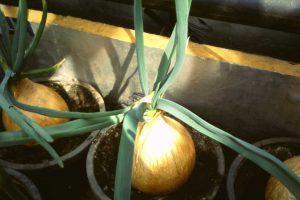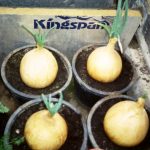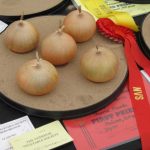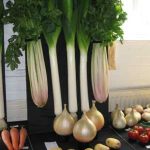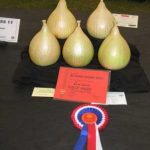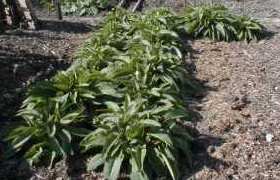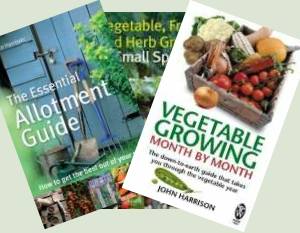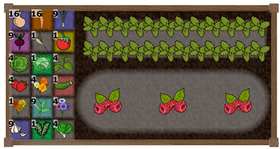Show grower John Trim has won the national championship with his onions. In this article on growing onions for show, he reveals the secrets of selecting and developing the best strain to get you the winner’s red card at the show.
To grow show winning onions you need to start with the best seed. Not just the best you can buy but the best you can develop by selecting your own seed.
If you have a good strain of onion that you wish to retain and even improve upon, here’s how to go about it.
Selecting the Best Onion Bulbs
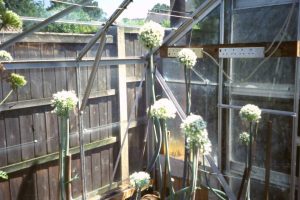
These onions have been moved into a greenhouse whilst flowering to avoid cross pollination from other onions.
At the end of the showing season select half a dozen of your very best onions that display the characteristics you wish to retain. This could be to attain a type of shape, or maybe reselecting for the heaviest.
Be ruthless in your selection, choose only those onions that grew with slim necks, disregard those with ‘thick bull necks” and make sure that the bulbs are disease free.
Check around the root plate for any splits or softness and have a good sniff. If it smells bad discard it. Keep only the very best bulbs for seeding.
Prepare the Onion Bulbs
Having made your selection the bulbs must be dried before planting up in the spring. The best way to do this is to trim the neck of the onion down to within 1”/25mm of the onion bulb.
The onions are then inverted neck down and placed on a small bucket or tube in a dry, cool well ventilated place for 6 weeks. This will allow any moisture in the bulbs to drain out. This will also help to avoid the onset of botrytis in the neck of the onion.
After this period of drying the bulbs should be hung up in individual nets until planting time in the spring. The bulbs are then planted up in 20 litre flower pots using sterilised top soil. Only the base of the onion is buried below soil level, just an inch or so deep.
Pollination
The onion will throw up fresh foliage followed by a flower spike which should be supported with a cane. In early summer this will develop into a flower head. Allium flowers cannot fertilise themselves in isolation. This is because the male anthers open first and shed their pollen before the female stigma of that flower is receptive.
The individual flowers, of which there are hundreds on each seed head open over a period of 4 weeks with the maximum opening in the second week. Group your individual onions closely together so that the pollinating insects can go easily from flower to flower and thereby cross pollinate with the neighbouring seed heads.
Keeping the Strain of Onions Pure
Unfortunately your flowering seed heads will cross pollinate with any other onion strain that is in flower at the same time as yours, and that can be up to a mile distant. In order to avoid cross pollination it will be necessary to enclose the flowers in an enviromesh bag placed over each seed head and secured round the stem with a strong elastic band or a clothes peg.
When the heads are in flower remove the bags and go over the heads with a soft paint brush, do this in the morning then quickly replace the bags. This is best done in the second week of flowering.
Brush them 3 or 4 times over a period of a week to attain fertilisation. Be careful to keep any insects off the heads whilst doing this. them. You don’t want any stray pollen introduced to the seed heads.
An alternative to this method is to move all the onions under cover where no bee or fly can get to them. And don’t forget to clean the brush in alcohol after you use it.
Once all the flowers have died back the enviromesh bags can be removed.
Harvesting the Onion Seed
When the pods are completely dry the rest of the seed can be harvested by gently rubbing between the palms of your hands. This is one of those jobs I reserve for winter time. Pick out the seed from the chaff, pop it into small brown paper bags, seal and store in the crisper section of your fridge.
The onion seed will remain viable for 2 to 3 years.



